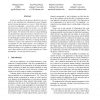503 search results - page 52 / 101 » Output privacy in data mining |
PVLDB
2010
14 years 10 months ago
2010
Random perturbation is a promising technique for privacy preserving data mining. It retains an original sensitive value with a certain probability and replaces it with a random va...
ICDM
2009
IEEE
15 years 6 months ago
2009
IEEE
—We describe an efficient algorithm for releasing a provably private estimate of the degree distribution of a network. The algorithm satisfies a rigorous property of differenti...
FSKD
2008
Springer
15 years 28 days ago
2008
Springer
Preservation of privacy in micro-data release is a challenging task in data mining. The k-anonymity method has attracted much attention of researchers. Quasiidentifier is a key co...
SDM
2009
SIAM
15 years 9 months ago
2009
SIAM
Most existing work on Privacy-Preserving Data Mining (PPDM) focus on enabling conventional data mining algorithms with the ability to run in a secure manner in a multi-party setti...
SP
2006
IEEE
15 years 5 months ago
2006
IEEE
An all too real threat to the privacy offered by a mix network is that individual mix administrators may volunteer partial tracing information to a coercer. While this threat can ...

